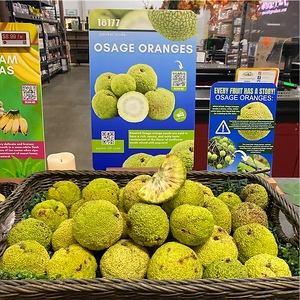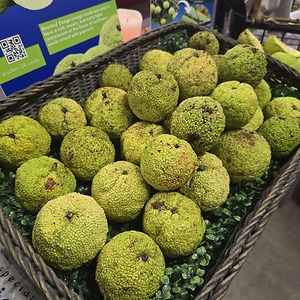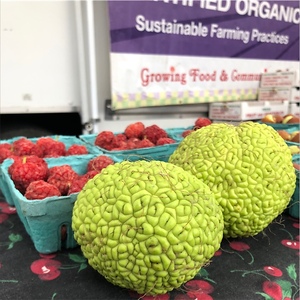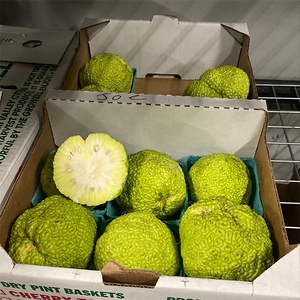

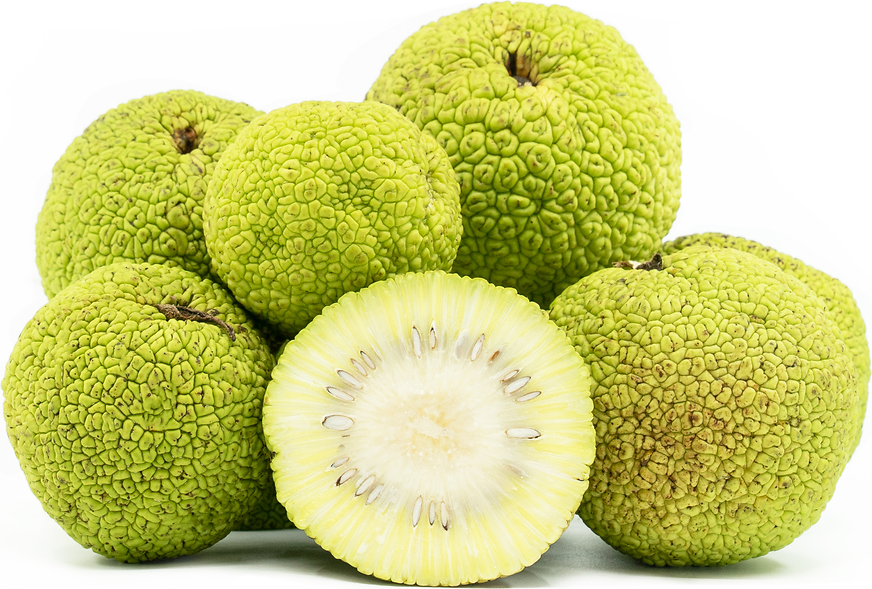
Osage Oranges
Estimated Inventory, ea : 0
This item was last sold on : 10/24/24
Description/Taste
Osage oranges are medium to large fruits, averaging 8 to 15 centimeters in diameter, and have a slightly lopsided, globular to oblong appearance, sometimes covered in protruding bumps. The species is a type of compound fruit, meaning it has developed from several carpels, also known as ovaries, that have fused, similar to jackfruit or mulberries. Osage oranges have a firm, textured, and deeply grooved surface, and the exterior ripens from green to shades of lime green, yellow-green, yellow, and bright green. The surface is also occasionally covered in wiry black-brown hairs and has a rugged, tough feel. Underneath the surface, the pale yellow-green to white flesh is solid, dense, and moist, with many flattened, oblong, light brown to cream-colored seeds embedded throughout the fruit. One Osage orange can contain anywhere from 200 to 300 seeds and the seeds are tightly fit into the flesh. When sliced, Osage oranges exude a sticky, milky, bitter white latex-like liquid that may be irritating to the skin. Osage oranges have a citrus-forward scent that is said to smell like orange peels. The fruits are not typically consumed and have an astringent, bitter, green flavor with mild notes of cucumber. Most consumers deem the flavor unpleasant, and there are some records of indigestion and ill feelings after fruit consumption. It is recommended to avoid eating the flesh of the fruits and only extracting the seeds for use as a roasted snack. Roasted Osage orange seeds are said to have a rich, savory, and nutty taste reminiscent of the flavor of sunflower seeds mixed with popcorn.
Seasons/Availability
Osage oranges are available in North America in the late summer through fall, with a peak season of September through October.
Current Facts
Osage oranges, botanically classified as Maclura pomifera, are a rare North American species belonging to the Moraceae family, along with jackfruit, mulberries, and breadfruit. The seasonal fruits develop on fast-growing, deciduous trees reaching 8 to 15 meters in height, and the trees begin bearing fruit approximately ten years after planting. The leaves grow in alternate arrangements along the branches with distinct thorny petioles or stems, and the branches extend in many directions, allowing the trees to be used as property barriers. Osage orange trees are famous for their dense wood, which has a distinct orange tint to the graining. The fruits acquired their “orange” moniker from the tree’s signature orange wood. They were also named for their faint orange-like scent and round shape. Osage orange fruits are a secondary element to the tree’s use as lumber, and the fruits are not consumed, making them a curious foraged good. The species is known throughout the United States as Hedge apples, Bow-wood, Horse apples, Monkey Ball, and Mock orange. Osage orange trees were once one of the most planted trees in the central United States, used as a natural fence or barrier, but with advancements in technology, the trees have become a rare species often removed from properties. Osage oranges are foraged by fruit enthusiasts as a natural air freshener, decorative element, natural insect repellent, and the seeds are extracted and roasted as a culinary snack.
Nutritional Value
Osage oranges are not commonly consumed, making the fruits mostly unstudied for their nutritional properties. The fruits are thought to contain some essential oils and antioxidants. According to Midwestern folklore, Osage oranges are sometimes used as a natural insect repellant. This is a heavily debated topic, and the efficacy remains uncertain, but in general, folkloric uses involved slicing the fruits and leaving them around the house, thought to repel spiders, cockroaches, mosquitos, and rodents. The wood from the tree can also be made into sawdust and boiled into a fabric dye. This dye was used to color fabric and imparted yellow-orange hues.
Applications
Osage oranges are a peculiar fruit as humans, and most animals choose not to consume the bitter flesh. Some animals, such as squirrels and deer, consume the seeds, but the fruits earned their inedible reputation due to livestock choking on them and dying. Despite many misinterpretations of the fruit being inedible, the fruit is edible but is not commonly consumed due to its unpalatable features, such as the bitter flavor and unpleasant latex-like liquid that can irritate the skin. Beyond the flesh, the seeds are edible and can be roasted. Removing the seeds from the flesh is a painstaking process, and one fruit can contain 200 to 300 seeds. The seeds are removed by hand, and the fruits are commonly soaked and macerated in water to soften their flesh. Once the flesh has relaxed, ripe seeds can be sifted from the flesh. Mature seeds will sink to the bottom of a water-filled container, while unripe and empty seeds, flesh pieces, and other discards will float to the top. The collected seeds should be washed and cleaned before use. Once cleaned, the seeds are left to air-dry and are later roasted in oil and salt to create a crunchy snack. Osage orange seeds have a nutty flavor that is reminiscent of a cross between a sunflower seed mixed with popcorn. In addition to consuming the seeds, the fruits are generally kept as ornamental decoration or are used as an air freshener for a couple of weeks when stored in a cool place away from direct sunlight.
Ethnic/Cultural Info
Osage oranges are known for their durable, decay-resistant wood and are sacred among the Osage Nation. Hunters from the nation constructed their best bows from the wood, and it is thought that tribe members would travel hundreds of miles to find a single tree. The bows were carved from pieces of the tree’s limbs, and the Osage craftsmen were skilled at removing only small pieces of wood from the branches so as not to kill the branch and damage the tree. The piece was then carved into a wooden bow, and these bows were so prized for their resilient nature that they were found over two thousand miles away in other tribes, often distributed through trade. When French settlers encountered the Osage Nation’s handmade bows, they named the Osage orange tree Bois D’Arc, which means “wood for a bow.” Later in history, as more European settlers expanded into the region, Osage orange trees transitioned into a new role and became the premier fencing along property lines in the Great Plains. The trees bear sharp spines, and the twisting branches would be interwoven with branches from neighboring Osage orange trees to create a living, armed fence. These fences would mature in four years and were given the slogan “horse high, bull-strong, and hog-tight” to keep animals within property lines. Osage orange trees were planted for thousands of miles and were one of the most sought-after trees during this time. The tree's popularity quickly faded with the invention of barbed wire, which was rumored to have been modeled after the thorny Osage branches. With time, Osage orange trees retreated to their original purpose of being used for their wood and were chopped down to make fence posts to run the new barbed wire. The wood is still considered one of the most decay-resistant woods in North America.
Geography/History
Osage oranges are native to the South-Central United States, mainly in the Red River region, spanning Arkansas, Texas, and Oklahoma. The species has been growing wild since ancient times and was thought to have been consumed by now-extinct herbivores, including mastodons, giant sloths, and woolly mammoths, during the Pleistocene Epoch over two million years ago. These large animals are hypothesized to have spread the species by eating the fruits and scattering seeds in their excrement. Over time, the megafauna went extinct, but Osage orange trees remained, later becoming a source of wood-building materials among the indigenous populations. Osage oranges are extensively intertwined into the history of the Osage Nation, as their ancestral lands overlap the fruit’s native region. The species acquired its Osage moniker sometime during the 16th and 17th centuries, and in 1804, Scottish explorer William Dunbar wrote the first account of the species in English. Throughout the 19th century, Osage orange trees quickly spread across the Great Plains and into the south as a living fence and were planted in rows that stretched for miles to divide farm property lines. They were also one of the main trees used in President Franklin Delano Roosevelt’s “Great Plains Shelterbelt,” a WPA Project started in 1934 to prevent soil erosion. Over 200 million trees were planted during this project, spreading the presence of Osage oranges throughout the United States. Today, Osage orange trees thrive on plains, pastures, thickets, forests, farmland, woods, and alongside streams. The species is only found in North America and stretches from regions of the United States into Canada. When in season, Osage oranges can be foraged from wild trees and are utilized for aromatic purposes. The fruits are not commonly sold in local markets and are mostly offered directly through farmers and foragers.
Recipe Ideas
Recipes that include Osage Oranges. One
| Dylan's Blog |
|
Osage Orange Wine |



